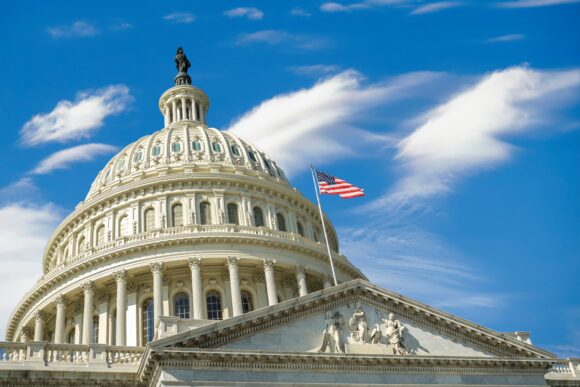Michelle Sartain, president Marsh U.S. and Canada, who has worked at Marsh for more than 28 years, encouraged lawmakers on Capitol Hill last month to reauthorize the Terrorism Risk Insurance Act. More than two decades after Marsh McLennan lost 358 employees in the terrorist attack on the World Trade Center on Sept. 11, 2001, the backstop remains a necessary component to a stable insurance market, she said.
“By all accounts, the program has been a model public-private partnership,” said Sartain. “The backstop remains a critical component to a stable terror insurance market, particularly for nuclear, biological, chemical, and radiological (NBCR) events, and has enabled insurance to be placed and investments to be made.”
The federal backstop for terrorism risk was first initiated late in 2002 to respond to insurers’ forced exclusion of terrorism risks from commercial property/casualty insurance policies following losses from the terrorist attacks. The change put construction projects on hold since financers required the insurance. Meanwhile, a crisis began in workers’ compensation due to the high levels of exposure faced in the line of business since state laws prohibited a terrorism exclusion.
The legislation requires insurers to offer terrorism coverage while the industry has the assurance that if losses from an event reach certain thresholds (the event needs to exceed $5 million in damages to be certified as an act of terrorism and cost insurers $200 million in industry losses to trigger coverage), the government will step in. TRIA has been reauthorized several times, the latest at the end of 2019. It is due to expire again on Dec. 31, 2027.
Sartain offered 17 pages of testimony covering TRIA’s history and features, and outlined how certain industries such as healthcare and higher education rely on TRIA. On Sept. 17 she told the U.S. House Financial Services Subcommittee on Housing and Insurance that the terrorism backstop allows for insurers and reinsurers to quantify exposures and provide capacity into the market.
Although the expiration is two years away, “insurers and rating agencies closely monitor legislative activity related to [TRIA],” Sartain explained. “Any uncertainty regarding the future of the federal backstop as the deadline approaches will have an impact on the availability and nature of insurance coverage. That, in turn, could send ripple effects through the economy and potentially affect companies’ decision-making processes about hiring and investing.”
If the backstop expires without a replacement, “insurers that are still able to offer terrorism coverage will likely only write coverage for buyers with operations in preferred locations, and could consider increasing prices for other locations,” Sartain wrote. “This would lead to capacity shortfalls for central business districts, at-risk industries, and employers with significant workers’ compensation accumulations, such as office workers, manufacturing facilities, and healthcare and education facilities,” she continued.
Elizabeth Heck, former chair of the National Association of Mutual Insurance Companies (NAMIC), also testified before the subcommittee. She said TRIA provides certainty and has allowed insurers to offer coverage.
“Thankfully, the program has yet to be tested, and as we look back nearly 25 years after the attacks, it is important to recognize how much construction and economic development TRIA has supported, all at no cost to the taxpayers,” she said.
Heck, president and CEO of Greater New York Insurance Company, said she has experience as a “major writer of terror-exposed property in New York City.”
“While insuring against the financial devastation that could accompany a catastrophic terrorist attack might sound like a reasonable protective measure for markets to take on, a large-scale terrorist attack–like an act of war–is not insurable,” Heck submitted to the committee.
About 79% of commercial multiperil policies in the U.S. include some level of terrorism coverage, and insurer appetite for the risk has increased. While NAMIC generally opposes federal backstop programs, Heck said TRIA “represents the rare situation where a clearly defined problem can only be solved by a federal partnership to facilitate insurability in a way that does not harm markets or market participants and ultimately reduces risk against scenarios where other solutions have been exhausted.”
NAMIC proposed a 10-year reauthorization with no significant changes to the program’s structure.
The American Property Casualty Insurance Association (APCIA) did not testify at the hearing but called on Congress to reauthorize TRIA with no change to financial thresholds. In a statement, Sam Whitfield, senior vice president of federal government relations, added: “TRIA is a fiscally sound program that has operated for 23 years with minimal cost to taxpayers. Its continued existence is vital to maintaining confidence in the marketplace and ensuring the availability of terrorism coverage that businesses and communities rely on.”
Topics Catastrophe Natural Disasters
Was this article valuable?
Here are more articles you may enjoy.



 Truckers Who Fail English Tests Are Pulled Off Roads in Crackdown
Truckers Who Fail English Tests Are Pulled Off Roads in Crackdown  Brookfield Targets Global Dominance in P/C Insurance Coverage
Brookfield Targets Global Dominance in P/C Insurance Coverage  In Alabama, Shot Employee Gets No Workers’ Comp and No Employer’s Liability
In Alabama, Shot Employee Gets No Workers’ Comp and No Employer’s Liability  Acrisure to Buy MGA Vave From Canopius
Acrisure to Buy MGA Vave From Canopius 



